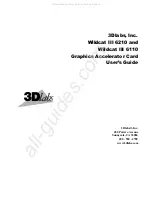
Chapter 1: Introduction
This Serial Interface Card was designed for effective multipoint transmission in RS485 (EIA485)
protocol. The card is 6.0 inches long and may be installed in 5-volt PCI-bus slots of IBM PC or
compatible computers. The card features four independent, asynchronous RS485 serial ports, type
16550 buffered UARTS, and, for Windows compatibility, automatic control to transparently
enable/disable the transmission drivers.
There are two I/O connector options. The standard model includes two 9-pin male connectors on the
card mounting bracket plus a second mounting bracket with two more 9-pin male connectors with
ribbon cables to connect them to headers on the card. Model S1 includes a single 25-pin connector on
the mounting bracket plus a "spider" or breakout cable that terminates in four 9-pin D-type connectors.
RS485 Balanced Mode Operation
The card supports RS485 communications and uses differential balanced drivers for long range and
noise immunity. RS485 operation involves switchable transceivers and the ability to support multiple
devices on a single "party line". The RS485 specification defines a maximum of 32 devices on a single
line. The number of devices served on a single line can be expanded by use of "repeaters".
RS485 communications requires that one transmitter supply a bias voltage to ensure a known "zero"
state when all transmitters are off. Also, receiver inputs at each end of the network should be
terminated to eliminate "ringing". The card supports biasing by default and supports termination by
jumpers on the card. If your application requires the transmitter to be un-biased, please contact the
factory.
COM Port Compatibility
Type 16550 UARTs are used as the Asynchronous Communication Element (ACE). These have a 16-
byte transmit/receive buffer to protect against lost data in multitasking operating systems, while
maintaining 100 percent compatibility with the original IBM serial port. The system assigns the
address(es).
A crystal oscillator is located on the card. This oscillator ensures precise selection of baud rate up to
115,200 or, by changing a jumper, up to 460,800.
The driver/receiver used, the SN75176B, is capable of driving extremely long communication lines at
high baud rates. It can drive up to +60 mA on balanced lines and receive inputs as low as 200 mV
differential signal superimposed on common mode noise of +12 V or -7 V. In case of communication
conflict, the driver/receivers feature thermal shutdown.
Communication Mode
This card supports Half-Duplex communications with a 2-wire cable connection. Half-Duplex allows
traffic to travel in both directions, but only one way at a time. RS485 communications commonly use the
Half-Duplex mode since they share only a single pair of wires.
Baud Rate Ranges
The card has capability for two baud rate ranges and you can select which you wish to use on a port-
by-port basis. One range is up to 115,200 baud applications and the other is up to 460,800 baud.
Содержание PCI-COM485/4
Страница 8: ...Figure 1 1 Block Diagram Only one serial channel shown ...
Страница 13: ...Figure 3 2 Option Selection Map ...







































